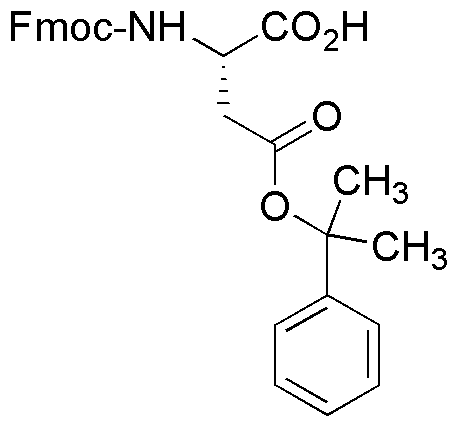Fmoc-L-aspartic acid b-2-phenylisopropyl ester is widely utilized in research focused on:
- Peptide Synthesis: This compound serves as a key building block in the synthesis of peptides, particularly in solid-phase peptide synthesis (SPPS), allowing for the creation of complex peptide structures with high purity.
- Drug Development: Its unique properties make it valuable in the pharmaceutical industry for developing new drugs, especially those targeting neurological disorders, by modifying peptide chains for improved efficacy.
- Bioconjugation: The compound is used in bioconjugation processes, where it helps to attach biomolecules to surfaces or other molecules, enhancing the stability and functionality of therapeutic agents.
- Research in Neuroscience: Researchers utilize it to study neurotransmitter pathways and receptor interactions, contributing to a better understanding of brain function and potential treatments for mental health conditions.
- Customizable Drug Delivery Systems: Its ability to form various derivatives allows for the design of tailored drug delivery systems, improving the targeting and release profiles of therapeutic agents.
General Information
Properties
Safety and Regulations
Applications
Fmoc-L-aspartic acid b-2-phenylisopropyl ester is widely utilized in research focused on:
- Peptide Synthesis: This compound serves as a key building block in the synthesis of peptides, particularly in solid-phase peptide synthesis (SPPS), allowing for the creation of complex peptide structures with high purity.
- Drug Development: Its unique properties make it valuable in the pharmaceutical industry for developing new drugs, especially those targeting neurological disorders, by modifying peptide chains for improved efficacy.
- Bioconjugation: The compound is used in bioconjugation processes, where it helps to attach biomolecules to surfaces or other molecules, enhancing the stability and functionality of therapeutic agents.
- Research in Neuroscience: Researchers utilize it to study neurotransmitter pathways and receptor interactions, contributing to a better understanding of brain function and potential treatments for mental health conditions.
- Customizable Drug Delivery Systems: Its ability to form various derivatives allows for the design of tailored drug delivery systems, improving the targeting and release profiles of therapeutic agents.
Documents
Safety Data Sheets (SDS)
The SDS provides comprehensive safety information on handling, storage, and disposal of the product.
Product Specification (PS)
The PS provides a comprehensive breakdown of the product’s properties, including chemical composition, physical state, purity, and storage requirements. It also details acceptable quality ranges and the product's intended applications.
Certificates of Analysis (COA)
Search for Certificates of Analysis (COA) by entering the products Lot Number. Lot and Batch Numbers can be found on a product’s label following the words ‘Lot’ or ‘Batch’.
Número de catálogo
Número de lote/lote
Certificates Of Origin (COO)
This COO confirms the country where the product was manufactured, and also details the materials and components used in it and whether it is derived from natural, synthetic, or other specific sources. This certificate may be required for customs, trade, and regulatory compliance.
Número de catálogo
Número de lote/lote
Safety Data Sheets (SDS)
The SDS provides comprehensive safety information on handling, storage, and disposal of the product.
DownloadProduct Specification (PS)
The PS provides a comprehensive breakdown of the product’s properties, including chemical composition, physical state, purity, and storage requirements. It also details acceptable quality ranges and the product's intended applications.
DownloadCertificates of Analysis (COA)
Search for Certificates of Analysis (COA) by entering the products Lot Number. Lot and Batch Numbers can be found on a product’s label following the words ‘Lot’ or ‘Batch’.
Número de catálogo
Número de lote/lote
Certificates Of Origin (COO)
This COO confirms the country where the product was manufactured, and also details the materials and components used in it and whether it is derived from natural, synthetic, or other specific sources. This certificate may be required for customs, trade, and regulatory compliance.


